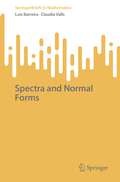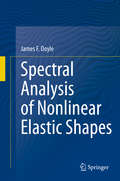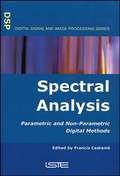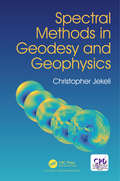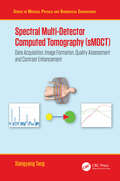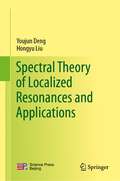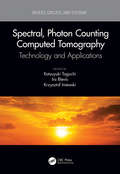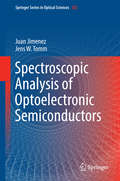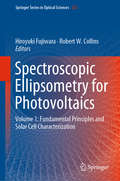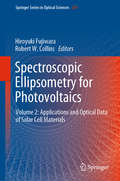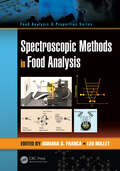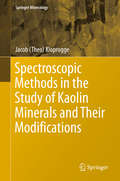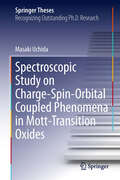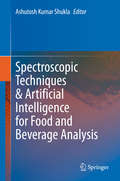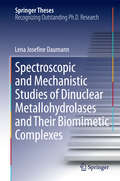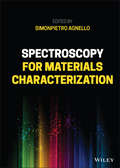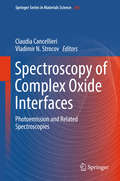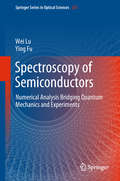- Table View
- List View
Spectra and Normal Forms (SpringerBriefs in Mathematics)
by Claudia Valls Luís BarreiraThis book presents the reader with a streamlined exposition of the notions and results leading to the construction of normal forms and, ultimately, to the construction of smooth conjugacies for the perturbations of tempered exponential dichotomies. These are exponential dichotomies for which the exponential growth rates of the underlying linear dynamics never vanish. In other words, its Lyapunov exponents are all nonzero. The authors consider mostly difference equations, although they also briefly consider the case of differential equations. The content is self-contained and all proofs have been simplified or even rewritten on purpose for the book so that all is as streamlined as possible. Moreover, all chapters are supplemented by detailed notes discussing the origins of the notions and results as well as their proofs, together with the discussion of the proper context, also with references to precursor results and further developments. A useful chapter dependence chart is included in the Preface. The book is aimed at researchers and graduate students who wish to have a sufficiently broad view of the area, without the discussion of accessory material. It can also be used as a basis for graduate courses on spectra, normal forms, and smooth conjugacies.The main components of the exposition are tempered spectra, normal forms, and smooth conjugacies. The first two lie at the core of the theory and have an importance that undoubtedly surpasses the construction of conjugacies. Indeed, the theory is very rich and developed in various directions that are also of interest by themselves. This includes the study of dynamics with discrete and continuous time, of dynamics in finite and infinite-dimensional spaces, as well as of dynamics depending on a parameter. This led the authors to make an exposition not only of tempered spectra and subsequently of normal forms, but also briefly of some important developments in those other directions. Afterwards the discussion continues with the construction of stable and unstable invariant manifolds and, consequently, of smooth conjugacies, while using most of the former material.The notion of tempered spectrum is naturally adapted to the study of nonautonomous dynamics. The reason for this is that any autonomous linear dynamics with a tempered exponential dichotomy has automatically a uniform exponential dichotomy. Most notably, the spectra defined in terms of tempered exponential dichotomies and uniform exponential dichotomies are distinct in general. More precisely, the tempered spectrum may be smaller, which causes that it may lead to less resonances and thus to simpler normal forms. Another important aspect is the need for Lyapunov norms in the study of exponentially decaying perturbations and in the study of parameter-dependent dynamics. Other characteristics are the need for a spectral gap to obtain the regularity of the normal forms on a parameter and the need for a careful control of the small exponential terms in the construction of invariant manifolds and of smooth conjugacies.
Spectral Analysis of Nonlinear Elastic Shapes
by James F. DoyleThis book concerns the elastic stability of thin-walled structures — one of the most challenging problems facing structural engineers because of its high degree of nonlinearity — and introduces the innovative approach of using spectral analysis of the shapes and the stiffness to gain insights into the nonlinear deformations. The methodology greatly facilitates correlating the shape changes with the stiffness changes. Professor Doyle also develops specific computer procedures that complement finite element methods so that the ideas and methods are applicable to general structural problems. Basic validity of the procedures is established using key archetypal problems from buckling/post-buckling of columns, arches, curved plates, and cylindrical shells, all worked out in significant detail. The book is ideal for a wide variety of structural engineers, particularly those in aerospace and civil fields. Researchers in computational mechanics also find a rich source of new ideas for post-processing data from nonlinear analyses.
Spectral Analysis: Parametric and Non-Parametric Digital Methods (Wiley-iste Ser.)
by Francis CastaniéThis book deals with these parametric methods, first discussing those based on time series models, Capon’s method and its variants, and then estimators based on the notions of sub-spaces. However, the book also deals with the traditional “analog” methods, now called non-parametric methods, which are still the most widely used in practical spectral analysis.
Spectral Methods in Geodesy and Geophysics
by Christopher JekeliThe text develops the principal aspects of applied Fourier analysis and methodology with the main goal to inculcate a different way of perceiving global and regional geodetic and geophysical data, namely from the perspective of the frequency, or spectral, domain rather than the spatial domain. The word "methods" in the title is meant to convey that the transformation of a geophysical signal into the spectral domain can be applied for purposes of analysis as well as rapid computation. The text is written for graduate students; however, Chapters 1 through 4 and parts of 5 can also benefit undergraduates who have a solid and fluent knowledge of integral and differential calculus, have some statistical background, and are not uncomfortable with complex numbers. Concepts are developed by starting from the one-dimensional domain and working up to the spherical domain, which is part of every chapter. Many concepts are illustrated graphically with actual geophysical data primarily from signals of gravity, magnetism, and topography.
Spectral Mixture for Remote Sensing: Linear Model and Applications (Springer Remote Sensing/Photogrammetry)
by Yosio Edemir Shimabukuro Flávio Jorge PonzoniThis book explains in a didactic way the basic concepts of spectral mixing, digital numbers and orbital sensors, and then presents the linear modelling technique of spectral mixing and the generation of fractional images. In addition to presenting a theoretical basis for spectral mixing, the book provides examples of practical applications such as projects for estimating and monitoring deforested areas in the Amazon. In its seven chapters, the book offers remote sensing techniques to understand the main concepts, methods, and limitations of spectral mixing for digital image processing. Chapter 1 addresses the basic concepts of spectral mixing, while chapters 2 and 3 discuss digital numbers and orbital sensors such as MODIS and Landsat MSS. Chapter 4 details the linear spectral mixing model, and chapter 5 talks about how to use this technique to create fraction images. Chapter 6 offers remote sensing applications of fraction images in deforestation monitoring, burned-area mapping, selective logging detection, and land-use/land-cover mapping. Chapter 7 gives some concluding thoughts on spectral mixing, and considers future uses in environmental remote sensing. This book will be of interest to students, teachers, and researchers using remote sensing for Earth observation and environmental modelling.
Spectral Multi-Detector Computed Tomography: Data Acquisition, Image Formation, Quality Assessment and Contrast Enhancement (Series in Medical Physics and Biomedical Engineering)
by Xiangyang TangX-ray computed tomography (CT) has been one of the most popular diagnostic imaging modalities for decades in the clinic for saving patients’ lives or improving their quality of life. This book is an introductory one-stop shop for technological and clinical topics in multi-detector computed tomography (MDCT). Starting with MDCT’s fundamentals in physics and mathematics, the book provides an in-depth introduction to its system architecture and imaging chain, signal detection via energy-integration and photon-counting mechanisms, clinical application-driven scan modes and protocols, analytic and iterative image reconstruction solutions, and spectral imaging – the latest technological advancement in MDCT. The book extends its coverage on image quality assessment under the theory of signal detection and statistical decision. In recognition of its clinical relevance for conspicuity enhancement in angiographic and parenchymal imaging applications, the book features a chapter dedicated to the fundamental (chemical, physical and physicochemical) properties and clinical administration of iodinated contrast agent. The book ends with an outlook of the contrast agents that are novel in material and delivery, and their synergy with spectral MDCT to elevate CT’s contrast resolution in cardiovascular, neurovascular and oncologic applications. This book will be an invaluable reference for researchers, engineers, radiological physicians and technologists, and graduate and senior undergraduate students. Features Provides an accessible introduction to the subject Up to date with the latest advances in emerging technologies and procedures Provides a historical overview of CT technology Xiangyang Tang, PhD, is an imaging scientist with extensive research and development experience in industry (GE Healthcare), academia (Emory University School of Medicine) and the clinic (Emory Healthcare). With a focus on computed tomography, Tang has been working in the field of medical imaging for more than 20 years. He is a professor of radiology and imaging sciences at Emory University School of Medicine, Fellow of SPIE (International Society for Optics and Photonics) and Fellow of AAPM (American Association of Physicists in Medicine). Along with the publication of more than 200 papers in leading scientific journals and conferences, his contributions to the scientific community include serving as associate editor for a number of prestigious journals, in addition to working on the scientific committees of leading conferences and panels for numerous federal and foundational study sections.
Spectral Theory of Localized Resonances and Applications
by Hongyu Liu Youjun DengThis book is devoted to the spectral theory of localized resonances including surface plasmon/polariton resonances, atypical resonances, anomalous localized resonances and interior transmission resonances. Those resonance phenomena arise in different physical contexts, but share similar features. They form the fundamental basis for many cutting-edge technologies and applications including invisibility cloaking and super-resolution imaging. The book presents a systematic and comprehensive treatment on these resonance phenomena and the associated applications in a unified manner from a mathematical and spectral perspective, covering acoustic, electromagnetic and elastic wave scattering.The book can serve as a handy reference book for researchers in this field and it can also serve as a textbook or an inspiring source for postgraduate students who are interested in entering this field.
Spectral, Convolution and Numerical Techniques in Circuit Theory
by Fuad BadriehThis book describes a set of tools and algorithms then enable the electrical engineer in fields such as circuit design, power delivery, signal integrity, analog design, package and board modeling to arrive at approximate and exact solutions robustly and relatively efficiently, even when typical software packages may fail to do so. By leveraging well established and time tested methods, the author demonstrates how the practitioner will be able to deal with various circuit design problems and signal integrity issues both in the frequency and time domains. The presented tool set is an alternative to “brute force” time discretization and software utilization, offering great insight into the operations of linear systems ranging from RLC networks to device modeling.
Spectral, Photon Counting Computed Tomography: Technology and Applications (Devices, Circuits, and Systems)
by Krzysztof Iniewski Katsuyuki Taguchi Ira BlevisSpectral, Photon Counting Computed Tomography is a comprehensive cover of the latest developments in the most prevalent imaging modality (x-ray computed tomography (CT)) in its latest incarnation: Spectral, Dual-Energy, and Photon Counting CT. Disadvantages of the conventional single-energy technique used by CT technology are that different materials cannot be distinguished and that the noise is larger. To address these problems, a novel spectral CT concept has been proposed. Spectral Dual-Energy CT (DE-CT) acquires two sets of spectral data, and Spectral Photon Counting CT (PC-CT) detects energy of x-ray photons to reveal additional material information of objects by using novel energy-sensitive, photon-counting detectors. The K-edge imaging may be a gateway for functional or molecular CT. The book covers detectors and electronics, image reconstruction methods, image quality assessments, a simulation tool, nanoparticle contrast agents, and clinical applications for spectral CT.
Spectrophotometric Determination of Palladium & Platinum: Methods & Reagents
by Ajay Kumar GoswamiThis versatile resource consolidates available methods for the spectrophotometric determination of palladium and platinum and serves as a practical ready-to-use guide for those researching palladium and platinum and for those working in the field of medicinal metal complexes of the two metals. The beauty of spectrophotometric methods lies in their simplicity, convenience, and easy operability, not to mention their cost-effectiveness. They can be automated easily and are thus the most affordable methods for the below reasons: Address analysts from all areas of industry, research labs and postgraduate students of analytical or medicinal chemistry as well as material science Detail all recently developed methods for palladium and platinum determination using spectrophotometry in a single source. Organized so that anyone interested in a particular method using a specific reagent can go directly to those details Facilitates the development of better methods for specific conditions of a sample
Spectroscopic Analysis of Optoelectronic Semiconductors
by Juan Jimenez Jens W. TommThis book deals with standard spectroscopic techniques which can be used to analyze semiconductor samples or devices, in both, bulk, micrometer and submicrometer scale. The book aims helping experimental physicists and engineers to choose the right analytical spectroscopic technique in order to get specific information about their specific demands. For this purpose, the techniques including technical details such as apparatus and probed sample region are described. More important, also the expected outcome from experiments is provided. This involves also the link to theory, that is not subject of this book, and the link to current experimental results in the literature which are presented in a review-like style. Many special spectroscopic techniques are introduced and their relationship to the standard techniques is revealed. Thus the book works also as a type of guide or reference book for people researching in optical spectroscopy of semiconductors.
Spectroscopic Ellipsometry for Photovoltaics: Volume 1: Fundamental Principles and Solar Cell Characterization (Springer Series in Optical Sciences #212)
by Hiroyuki Fujiwara Robert W. CollinsThis book provides a basic understanding of spectroscopic ellipsometry, with a focus on characterization methods of a broad range of solar cell materials/devices, from traditional solar cell materials (Si, CuInGaSe2, and CdTe) to more advanced emerging materials (Cu2ZnSnSe4, organics, and hybrid perovskites), fulfilling a critical need in the photovoltaic community.The book describes optical constants of a variety of semiconductor light absorbers, transparent conductive oxides and metals that are vital for the interpretation of solar cell characteristics and device simulations. It is divided into four parts: fundamental principles of ellipsometry; characterization of solar cell materials/structures; ellipsometry applications including optical simulations of solar cell devices and online monitoring of film processing; and the optical constants of solar cell component layers.
Spectroscopic Ellipsometry for Photovoltaics: Volume 2: Applications and Optical Data of Solar Cell Materials (Springer Series in Optical Sciences #214)
by Hiroyuki Fujiwara Robert W. CollinsSpectroscopic ellipsometry has been applied to a wide variety of material and device characterizations in solar cell research fields. In particular, device performance analyses using exact optical constants of component layers and direct analyses of complex solar cell structures are unique features of advanced ellipsometry methods. This second volume of Spectroscopic Ellipsometry for Photovoltaics presents various applications of the ellipsometry technique for device analyses, including optical/recombination loss analyses, real-time control and on-line monitoring of solar cell structures, and large-area structural mapping. Furthermore, this book describes the optical constants of 148 solar cell component layers, covering a broad range of materials from semiconductor light absorbers (inorganic, organic and hybrid perovskite semiconductors) to transparent conductive oxides and metals. The tabulated and completely parameterized optical constants described in this book are the most current resource that is vital for device simulations and solar cell structural analyses.
Spectroscopic Methods in Food Analysis (Food Analysis & Properties)
by Leo M.L. Nollet Adriana S. FrancaGiven the inherent complexity of food products, most instrumental techniques employed for quality and authenticity evaluation (e.g., chromatographic methods) are time demanding, expensive, and involve a considerable amount of manual labor. Therefore, there has been an increasing interest in simpler, faster, and reliable analytical methods for assessing food quality attributes. Spectroscopic Methods in Food Analysis presents the basic concepts of spectroscopic methods, together with a discussion on the most important applications in food analysis. The determination of product quality and authenticity and the detection of adulteration are major issues in the food industry, causing concern among consumers and special attention among food manufacturers. As such, this book explains why spectroscopic methods have been extensively employed to the analysis of food products as they often require minimal or no sample preparation, provide rapid and on-line analysis, and have the potential to run multiple tests on a single sample (i.e., non-destructive). This book consists of concepts related to food quality and authenticity, that are quite broad, given the different demands of the manufacturer, the consumer, the surveillance and the legislative bodies that ultimately provide healthy and safe products.
Spectroscopic Methods in the Study of Kaolin Minerals and Their Modifications (Springer Mineralogy Ser.)
by Jacob Theo KloproggeThis book systematically provides an overview of the use of a wide range of spectroscopic methods (Mid- and Near-Infrared, Infrared Emission, Raman, Solid-State Magic Angle Spinning Nuclear Magnetic Resonance, X-ray Photoelectron, Extended X-ray Absorption Fine Structure, X-ray Absorption Near Edge, Electron Spin and Mössbauer spectroscopy) to investigate kaolin minerals (kaolinite, dickite, nacrite and halloysite) and their modifications (intercalation compounds, nanocomposites and other modifications).
Spectroscopic Study on Charge-Spin-Orbital Coupled Phenomena in Mott-Transition Oxides
by Masaki UchidaIn this thesis the author presents the results of extensive spectroscopy experiments beyond the bounds of each transition element to clarify the origins of characteristic spectral features and charge dynamics in charge-spin-orbital coupled phenomena in Mott-transition oxides. Several counterpart 3d transition-metal oxides were adopted as model systems suitable for examining the mechanisms involved, and their electronic structures were systematically investigated using three main spectroscopy methods. Comparative studies on the charge dynamics and Mott transition features of transition-metal oxides were performed: Charge dynamics and thermoelectricity in a typical Mott transition system La1--xSrxVO3, charge dynamics in a doped valence-bond solid system (Ti1--xVx)2O3 and in layered nickelates R2-xSrxNiO4 with charge-ordering instability are investigated thoroughly. The results obtained successfully provide a number of novel insights into the emergent phenomena near the Mott transition.
Spectroscopic Techniques & Artificial Intelligence for Food and Beverage Analysis
by Ashutosh Kumar ShuklaThis informative book discusses the various spectroscopic techniques applied in the analysis of food and beverages. The respective chapters cover techniques such as Laser-Induced Breakdown Spectroscopy (LIBS), FTIR spectroscopy, Electron Spin Resonance (ESR) spectroscopy and Thermoluminescence. The book also presents artificial intelligence applications that can be used to enhance the spectral data analysis experience in food safety and quality analysis. Given its scope, the book will appeal to novice researchers and students in the area of food science. It offers an equally exciting read for food scientists and engineers working in the food industry.
Spectroscopic and Mechanistic Studies of Dinuclear Metallohydrolases and Their Biomimetic Complexes
by Lena Josefine DaumannLena Daumanns's thesis describes structural and functional studies of the enzyme Glycerophosphodiesterase (GpdQ) from Enterobacter aerogenes. It also examines the properties of small mimics of this enzyme and related binuclear metallohydrolases such as the metallo-ß-lactamases to enhance our understanding of hydrolytic cleavage of important substrates like phosphoesters and β-lactams. Overall, this project has led to a better understanding of the metal ion binding and active site structural features of the enzyme GpdQ. Daumann describes how she successfully immobilized phosphoesterase and related biomimetics on solid supports for potential applications in the area of bioremediation of organophosphate pesticides. Analysis shows that both the enzyme and biomimetics can be stored on the solid support without loss of activity. Furthermore, the author specroscopically and mechanistically characterized a number of Zn(II), Cd(II) and Co(II) complexes, some of which are among the most active biomimetics towards organophosphates reported to date. This thesis makes excellent reading for non-specialists because each chapter includes a short introduction section.
Spectroscopy and Characterization of Nanomaterials and Novel Materials: Experiments, Modeling, Simulations, and Applications
by Prabhakar MisraSpectroscopy and Characterization of Nanomaterials and Novel Materials Comprehensive overview of nanomaterial characterization methods and applications from leading researchers in the field In Spectroscopy and Characterization of Nanomaterials and Novel Materials: Experiments, Modeling, Simulations, and Applications, the editor Prabhakar Misra and a team of renowned contributors deliver a practical and up-to-date exploration of the characterization and applications of nanomaterials and other novel materials, including quantum materials and metal clusters. The contributions cover spectroscopic characterization methods for obtaining accurate information on optical, electronic, magnetic, and transport properties of nanomaterials. The book reviews nanomaterial characterization methods with proven relevance to academic and industry research and development teams, and modern methods for the computation of nanomaterials’ structure and properties - including machine-learning approaches - are also explored. Readers will also find descriptions of nanomaterial applications in energy research, optoelectronics, and space science, as well as: A thorough introduction to spectroscopy and characterization of graphitic nanomaterials and metal oxides Comprehensive explorations of simulations of gas separation by adsorption and recent advances in Weyl semimetals and axion insulators Practical discussions of the chemical functionalization of carbon nanotubes and applications to sensors In-depth examinations of micro-Raman imaging of planetary analogs Perfect for physicists, materials scientists, analytical chemists, organic and polymer chemists, and electrical engineers, Spectroscopy and Characterization of Nanomaterials and Novel Materials: Experiments, Modeling, Simulations, and Applications will also earn a place in the libraries of sensor developers and computational physicists and modelers.
Spectroscopy for Materials Analysis: An Introduction (SpringerBriefs in Materials)
by Kazuaki WagatsumaThis book includes X-ray fluorescence spectroscopy, electron spectroscopy, and atomic emission spectroscopy, which are now extensively employed in material analysis. This book is organized as a guide for undergraduate students and engineers who wish to study analytical spectroscopy in material science. An objective of this book is to explain the principles of those methods of spectroscopy only with basic mathematical expressions and to introduce their applications to actual materials.
Spectroscopy for Materials Characterization
by Simonpietro AgnelloSPECTROSCOPY FOR MATERIALS CHARACTERIZATION Learn foundational and advanced spectroscopy techniques from leading researchers in physics, chemistry, surface science, and nanoscience In Spectroscopy for Materials Characterization, accomplished researcher Simonpietro Agnello delivers a practical and accessible compilation of various spectroscopy techniques taught and used to today. The book offers a wide-ranging approach taught by leading researchers working in physics, chemistry, surface science, and nanoscience. It is ideal for both new students and advanced researchers studying and working with spectroscopy. Topics such as confocal and two photon spectroscopy, as well as infrared absorption and Raman and micro-Raman spectroscopy, are discussed, as are thermally stimulated luminescence and spectroscopic studies of radiation effects on optical materials. Each chapter includes a basic introduction to the theory necessary to understand a specific technique, details about the characteristic instrumental features and apparatuses used, including tips for the appropriate arrangement of a typical experiment, and a reproducible case study that shows the discussed techniques used in a real laboratory. Readers will benefit from the inclusion of: Complete and practical case studies at the conclusion of each chapter to highlight the concepts and techniques discussed in the material Citations of additional resources ideal for further study A thorough introduction to the basic aspects of radiation matter interaction in the visible-ultraviolet range and the fundamentals of absorption and emission A rigorous exploration of time resolved spectroscopy at the nanosecond and femtosecond intervals Perfect for Master and Ph.D. students and researchers in physics, chemistry, engineering, and biology, Spectroscopy for Materials Characterization will also earn a place in the libraries of materials science researchers and students seeking a one-stop reference to basic and advanced spectroscopy techniques.
Spectroscopy of Complex Oxide Interfaces: Photoemission And Related Spectroscopies (Springer Series in Materials Science #266)
by Claudia Cancellieri Vladimir N. StrocovThis book summarizes the most recent and compelling experimental results for complex oxide interfaces. The results of this book were obtained with the cutting-edge photoemission technique at highest energy resolution. Due to their fascinating properties for new-generation electronic devices and the challenge of investigating buried regions, the book chiefly focuses on complex oxide interfaces. The crucial feature of exploring buried interfaces is the use of soft X-ray angle-resolved photoemission spectroscopy (ARPES) operating on the energy range of a few hundred eV to increase the photoelectron mean free path, enabling the photons to penetrate through the top layers – in contrast to conventional ultraviolet (UV)-ARPES techniques. The results presented here, achieved by different research groups around the world, are summarized in a clearly structured way and discussed in comparison with other photoemission spectroscopy techniques and other oxide materials. They are complemented and supported by the most recent theoretical calculations as well as results of complementary experimental techniques including electron transport and inelastic resonant X-ray scattering.
Spectroscopy of High-Tc Superconductors: A Theoretical View
by N. M. PlakidaDespite ten years of intensive research, many questions remain unanswered concerning the nature of the electronic structure (Fermi vs non-Fermi liquid) and mechanisms of superconductivity. Spectroscopy of High-Tc Superconductors, A Theoretical View provides a current, comprehensive review of the experimental results and theoretical interpre
Spectroscopy of Semiconductors: Numerical Analysis Bridging Quantum Mechanics And Experiments (Springer Series in Optical Sciences #215)
by Ying Fu Wei LuThe science and technology related to semiconductors have received significant attention for applications in various fields including microelectronics, nanophotonics, and biotechnologies. Understanding of semiconductors has advanced to such a level that we are now able to design novel system complexes before we go for the proof-of-principle experimental demonstration.This book explains the experimental setups for optical spectral analysis of semiconductors and describes the experimental methods and the basic quantum mechanical principles underlying the fast-developing nanotechnology for semiconductors. Further, it uses numerous case studies with detailed theoretical discussions and calculations to demonstrate the data analysis. Covering structures ranging from bulk to the nanoscale, it examines applications in the semiconductor industry and biomedicine. Starting from the most basic physics of geometric optics, wave optics, quantum mechanics, solid-state physics, it provides a self-contained resource on the subject for university undergraduates. The book can be further used as a toolbox for researching and developing semiconductor nanotechnology based on spectroscopy.
Spectrum Access and Management for Cognitive Radio Networks
by Mohammad A MatinThis book presents cutting-edge research contributions that address various aspects of network design, optimization, implementation, and application of cognitive radio technologies. It demonstrates how to make better utilization of the available spectrum, cognitive radios and spectrum access to achieve effective spectrum sharing between licensed and unlicensed users. The book provides academics and researchers essential information on current developments and future trends in cognitive radios for possible integration with the upcoming 5G networks. In addition, it includes a brief introduction to cognitive radio networks for newcomers to the field.
